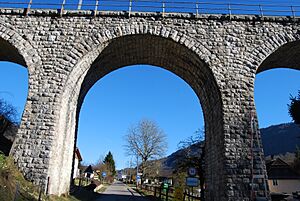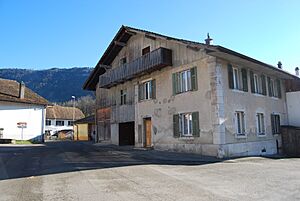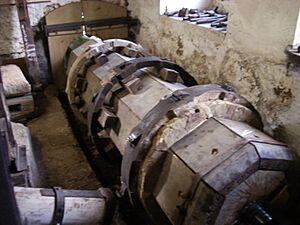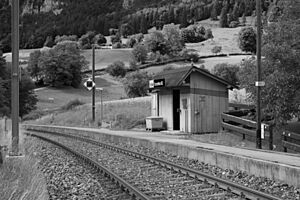Corcelles, Bern facts for kids
Quick facts for kids
Corcelles
|
||
|---|---|---|

Corcelles village
|
||
|
||
| Country | Switzerland | |
| Canton | Bern | |
| District | Jura bernois | |
| Area | ||
| • Total | 6.79 km2 (2.62 sq mi) | |
| Elevation | 655 m (2,149 ft) | |
| Population
(Dec 2020 )
|
||
| • Total | 201 | |
| • Density | 29.60/km2 (76.67/sq mi) | |
| Postal code |
2747
|
|
| Surrounded by | Crémines, Seehof/Elay, Vermes (JU), Gänsbrunnen (SO) | |
Corcelles is a small town, also called a municipality, in Switzerland. It is located in the Jura mountains in the canton of Bern. This part of Switzerland mainly speaks French.
Contents
History of Corcelles
Corcelles might have been first mentioned way back in 1181. People are still discussing if that first mention was definitely about this town.
For a long time, Corcelles was part of the church area called a parish in Grandval. In 1531, the people in this parish changed their religion. They became part of the Protestant Reformation.
Most of the time, the village was owned by the head of a monastery, called a provost, from Moutier-Grandval Abbey. In 1797, France won a war and Corcelles became part of France. It was first in the French area called Mont-Terrible. Then, in 1800, it moved to another French area called Haut-Rhin.
After Napoleon lost power, Corcelles became part of the Canton of Bern in 1815. This was decided at a big meeting called the Congress of Vienna.
Iron Mining and the Hammer Mill
People in Corcelles have been mining and melting iron for hundreds of years. A special factory with a water-powered hammer mill worked in the village from 1791 until 1955. Today, this old building has been fixed up and is now a museum.
From 1830 to 1842, a company called Ludwig von Rolls melted iron using a blast furnace here. Even though the iron industry was important, it was hard to get to Corcelles. So, from 1904 to 1908, a railway built a huge railroad bridge. This bridge helped connect the village to the rest of the country.
Geography of Corcelles
Corcelles covers an area of about 6.78 square kilometers. A big part of this land, about 41.5%, is used for farming. Forests cover even more, about 56.3% of the area. The rest, about 2.4%, has buildings and roads.
Most of the forest, 51.6% of the total land, is dense forest. Another 4.7% has fruit trees or small groups of trees. For farming, 7.5% of the land grows crops. About 12.7% is used for pastures where animals graze. Another 21.3% is used for alpine pastures, which are high mountain grasslands.
Corcelles is a "ribbon village." This means its houses are spread out in a long line along the eastern end of the Grand Val valley. Some houses are also on a mountain called Mont Raimeux.
The administrative district of Corcelles changed in 2010. It joined a new district called Arrondissement administratif Jura bernois.
Corcelles' Coat of Arms
The blazon of Corcelles' municipal coat of arms shows two fish. The background is split down the middle, with one side silver and the other red. The fish are also split, so a red fish is on the silver side and a silver fish is on the red side. These fish represent the fish found in the Gaibiat river, which flows through the town.
People of Corcelles (Demographics)
Corcelles has a population of about 214 people. A small number of people, about 3.1%, are foreign nationals. Over the last ten years, the population has slightly decreased.
Most people in Corcelles speak French. About 84.4% of the population speaks French as their main language. The second most common language is German, spoken by about 15.1% of the people. A very small number, 0.5%, speak Italian.
In 2008, the population was almost evenly split between males (49.8%) and females (50.2%). Most people living in Corcelles were born either in the town itself or in the same canton.
Age Groups
Children and teenagers (from birth to 19 years old) make up about 20.6% of the population. Adults (20 to 64 years old) are the largest group, making up 58.4%. Seniors (over 64 years old) make up 21% of the population.
Population Over Time
The chart below shows how the population of Corcelles has changed over many years:

Economy in Corcelles
In 2011, the unemployment rate in Corcelles was very low, at 0.86%. This means almost everyone who wanted a job had one.
In 2008, 70 people worked in Corcelles. These jobs were in different areas:
- Primary sector: 24 people worked in farming. There were 8 businesses in this area.
- Secondary sector: 19 people worked in making things or construction. There were 6 businesses here.
- Tertiary sector: 27 people worked in services, like shops or schools. There were 3 businesses in this area.
Many people who live in Corcelles travel to other towns for work. About 75 people commute away from Corcelles, while only 9 people commute into the town for work. This means Corcelles sends out more workers than it brings in. Most workers, about 61.3%, use a private car to get to work. About 11.3% use public transportation.
Taxes in Corcelles are similar to other places in Switzerland. In 2011, a married person earning 150,000 Swiss Francs paid about 13.2% in local and canton taxes.
Religion in Corcelles
Based on a census from 2000, about 52.2% of the people in Corcelles belonged to the Swiss Reformed Church. Another 22.9% were Roman Catholic.
Some people belonged to other Christian churches. About 3.9% of the population did not belong to any church. A small number of people did not answer the question about their religion.
Education in Corcelles
In Corcelles, many adults have finished their education. About 59.4% have completed upper secondary education, which is like high school. About 6.6% have gone on to higher education, like a university or a specialized college.
The school system in the Canton of Bern starts with one year of optional Kindergarten. After that, children go to six years of Primary school. Then, they have three years of lower Secondary school. In secondary school, students are grouped by their abilities. After lower Secondary, students can continue their schooling or start an apprenticeship to learn a trade.
In the 2011-2012 school year, 11 students attended classes in Corcelles. There were no kindergarten classes. There was one primary class with 11 students.
In 2000, 22 students went to school in Corcelles. Only 4 of these students lived and went to school in Corcelles. The other 18 students came from nearby towns. Also, 35 people who lived in Corcelles went to schools outside the town.
See also
 In Spanish: Corcelles (Berna) para niños
In Spanish: Corcelles (Berna) para niños










